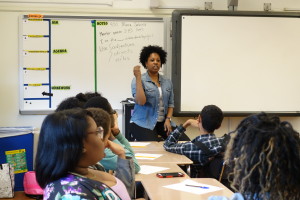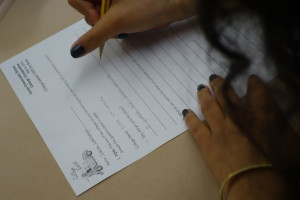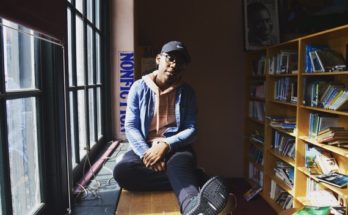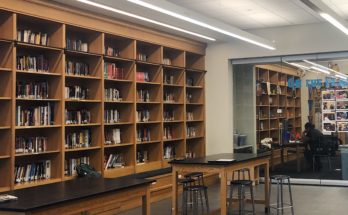The 12th graders passed a stuffed lion from one student to another in their U-shaped classroom at Brooklyn’s Lyons Community School, calling out the color of their mood as they went along. When his turn came, Damian Jean, 18, chose green: “because everything good is green—trees, plants. . . money.” He then turned to his left, pointing to his friend Jumaine Green: “and Jumaine.”
Green and Jean were participating in Friday afternoon’s advisory, a 20-minute session that takes place everyday for each grade at this 6th through 12th grade public school.The school places special emphasis on restorative justice and social-emotional learning, and advisories are meant for students to share their daily struggles and debate on specific topics, from conflict in their lives to their favorite objects of all time.
The school’s guidance counselor, Carmen Acosta, chose blue when her turn came, because too many seniors had not yet turned in their form for Free Application for Federal Student Aid (FAFSA.) “Do you know what free money is?” their teacher Kasi Addison piped in. “How long is it going to take you to sign up for ten thousand dollars?”

As the advisory wrapped up, Addison pointed the students she thought needed the most help with their college application to Brenda Velasquez, a 19-year-old graduate of the school with a black nose ring and half-brown, half-blond hair. Velasquez was using her semester break from City College to work as a “college coach” at her alma mater, where she would start by following the sixty five senior students during spring and keep up with a dozen of those most in need during the summer.
Working with Velasquez is a way for Lyons to get ahead of a problem that affects students all over the country. In the U.S., as many as one in five high school graduates who are accepted into college in the spring end up not enrolling over the summer. Benjamin Castleman, a professor at the University of Virginia who has studied the phenomenon, calls it the “summer melt.” For low-income, first-generation students, he calls it more of a “summer flood;” up to 40 percent of those accepted into college fail to enroll. Lyons partnered for the first time this year with a program called “College Bridge,” which was launched by SUNY in 2011 to combat the city’s summer melt. Unlike most other programs, the program takes into account social and cultural reasons that may hinder students from filling out complex financial and application forms. Many students who may need the most help don’t find it outside of the school environment. They can become overwhelmed, and give up.
Velasquez is one of 32 college students employed by the “College Bridge” program. Each is paired with a school chosen for its small size and individual approach to learning, explained its co-founder Janice Bloom, also professional development advisor at the Center for Professional Education of Teachers at Columbia Teachers College, in New York. Schools were able to select their own mentor. Velasquez was the “strongest academic student we’ve had in the entire history of the school, but more importantly, internally motivated,” said Lyons’ principal, Taeko Onishi. “Everyone likes and respects Brenda. She is a quiet uniter of people.”
Velasquez spent one Friday Afternoon in March walking around the corridors at Lyons, pulling students out of class to ask them about their applications, and gathering their phone numbers before graduation. Velasquez found herself playing catch up with all the students who were way behind schedule filling out their FAFSA forms.
Brenda has a first-hand appreciation of the barriers her students face in getting themselves into college. Like 96 percent of high school students nationally and most students at Lyons, Velasquez had her sights set on going to college while she was in high school. But unlike many of her classmates, she completed each step of the application process on time, even though neither of her parents went to college.

Carmen Acosta/Lyons Community School
At Lyons, only five out of 65 seniors said their parents had attended college. The 12th grade English and college preparation teacher, Kasi Addison, said most of them were also the first of their families to attend high school.
Green is one of them: nobody in his family ever attended college. In his essay for SUNY Canton where he was applying for a major in mechanical engineering, he wrote about his father’s murder, his brothers’ jailtime, and “how young black males get treated in this country.”
“I am the man of the house,” he wrote. “There are no other males, just myself, my mom and my two sisters.”
Addison said Green was among the students she was the most worried would not make it to college: not because his grades were the lowest, or because he wasn’t motivated enough, but because she was worried he would have an emotional reaction during the summer that would divert him from eventually attending.
But Green, who had sent his application and was still waiting for his acceptance letter, was determined. “I am going to be a mechanical engineer, I love cars, and I am going to get my Bachelor’s degree,” he wrote in his essay. Addison thought it would be good for him to get away from the city and his neighborhood, and so did he. “I’m from the projects, there is nothing for me here,” he explained.
Initially, the concept of the “summer melt” coaches was built around a college coach program initiated in Chicago in 2004, where adults with experience serving kids from Green’s background were hired to encourage them to apply to college. Jennifer Stephan of the American Institutes for Research wrote in 2013 that the model pushed coaches to act as middle-class parents do, actively overseeing their children’s educational career in ways low-income families often didn’t know how to.
In the same spirit College Bridge coaches, although they are not professionals, are encouraged to build a relationship with parents after attending training sessions to learn to do it right, and master every step of the financial aid process, explained Bloom. In March, Velasquez conducted a survey among her students to determine what workshops they would need. Three of their five main concerns were about finances: paying back loans, looking at bills and budgets and comparing financial aid packages. Getting students to believe they will be able to pay, and helping them through it, is key to get them to actually walk in their college in the fall.
But the trends in federal financial aid are not always on the side of those students. President Harry S. Truman’s G.I. Bill that offered free tuition to thousands of returning World War II veterans, and student loan programs which came later on, in the 1960s, increased access to higher education in America by unprecedented numbers. That trend reversed in the 1980s. Student loans have tripled in the past four decades, as federal funds have been steadily shrinking.
This led Bloom to write in her research into the college attendance gap between high and low income students that the educational choices of the poor and working-class youth were closely tied to their social class. She rejected the commonly held belief that low-income students enrolled in much smaller numbers because they were less prepared for college and didn’t grasp the value of higher education degrees.
She said that low-income students knew the value of a college degree, and the risks they faced. And those risks, as well the obstacles they have to cross in the process, were much more significant than the experiences of their middle and high-income counterparts.
Still, teachers and staff at Lyons try to tell students to apply first, and worry about the financial aspects later. “Don’t focus on the cost too much before you apply,” Addison said to one of her junior students enquiring about financial aid. “People are narrowing their choices too much. We are trying to prevent that.”

Lou Marillier/school-stories.com
Over the years, Addison became frustrated by Lyon’s low enrollment in college: 35 percent, compared to 63 percent citywide. So this past summer, in addition to partnering up with the College Bridge program and because they felt their students needed as much help as possible, Addison and the principal decided to start a special college prep class. Addison helped seniors through the application process during the first semester, and prepared juniors for the following year’s process in the second.
Other teachers were frustrated as well. A 12th grade science teacher, Joshua Paverud, remembered one of his senior students in particular who graduated three years ago,and with whom he had a very close relationship. The student was very enthusiastic about college, but became increasingly impatient as the weeks went by concerning financial aid. Unable to pay for his textbooks, he eventually dropped out. Another student from last year, 18-year-old Gustavo Amigon, attended his first three weeks at La Guardia Community College in Queens. But he quickly became overwhelmed trying to juggle his obligation to take his younger brothers to school everyday, and his side job walking dogs. He kept getting tangled up with the college’s financial aid requests to provide his mother’s tax records and her food stamp forms.
After going back and forth four times, his classes were eventually cancelled. He finally succeeded in enrolling again in the spring. “A lot of kids are in that boat,” said Paverud. He said that before Velasquez got on board and Addison started her College Prep class, “college application had been out of my sight. It was all on Carmen (Acosta, the guidance counselor) for years.”
But now, things at Lyons started changing. For example this year, Addison took the juniors in her college prep class for the school’s first trip ever to a college in another state: Temple University. Her college prep students were considered the “high fliers,” meaning they were the most likely to succeed.

Lou Marillier/school-stories.com
The teens chattered in a huddle before getting in the bus for Philadelphia. Angelea Germonsen, an energetic 15-year-old with two 2-inch braids emerging from his Patriots cap, had dreamed of becoming a firefighter ever since he was rescued by one when his head got stuck in something it shouldn’t have. Faith Redman, 16, wanted to study in an Ivy League university to become a plastic surgeon and help disfigured children abroad. Kemi Karim, 16, couldn’t wait to escape New York City and start college in two years. But out of the 25 students that Addison taught, four were missing, and their absence illustrated her daily struggle.
“Why isn’t Chris here?” Addison asked Germonsen, referring to one of the missing students.
“He had to get his phone fixed,” answered Germonsen.
The answer stunned Addison. She remained silent for a quarter of a second before bursting into her signature laugh, an infectious quality that only added to her popularity amongst the students.
The reasons for students’ absences are very often misunderstood, or dismissed by teachers, explained Bloom.
This is where coaches like Velasquez come in. Bloom explained that college coaches could better grasp the challenges students faced and translate possible solutions in a language that would make sense to them.
Indeed, Velasquez used techniques the average guidance counselor or teacher might not have considered. By mid-March, she still hadn’t heard from around 20 students out of the 65 she was supposed to track. Among them was Kimberley Guarneros, 21, who had failed her history Regents exam twice and was not coming to school much anymore.
Velasquez decided to contact her older sister Jessica, who was a fellow student with her at Lyons. “I don’t have her number but I have her on Instagram.” She sent a random picture accompanied by the sole message, “How are you?” A couple of weeks later, Velasquez was still catching up with Jessica, slowly, and subtly.
By mid-April, most students in Addison’s senior class had their names in Velasquez’s files, and received their acceptance letters from colleges. They were now preparing for graduation, and a large part of this Friday afternoon advisory session was dedicated to organizing the pictures for the yearbook, and most importantly, methods for paying for it.
Students who wanted Addison to call their families about their dues lined up at her desk, while others picked up laptops to start working on their weekly assignments. The advisory had been especially short that day to leave space for a large amount of homework, and a few students were leaving class one by one, unauthorized, instead of working on their assignments. Addison stationed her chair right by the door to catch them before they went out, but was unsuccessful.
As soon as she turned her back, Jean and Green managed to escape, and slowly walked towards the exit staircase, not listening to her calling them back. They both had been accepted to their first choices: Jean to SUNY Jefferson, in electrical engineering, and Greene to SUNY Canton, in mechanical engineering. “He says he is super excited about it,” said Addison.
“I’m not gonna make the money I want to make by staying here,” explained Green with a closed face, and a tightened jaw. As soon as the bell rang, the two students disappeared in the crowd. Their letters of acceptance in hands, the hardest part was yet to come – but this year, they wouldn’t have to face it alone.



